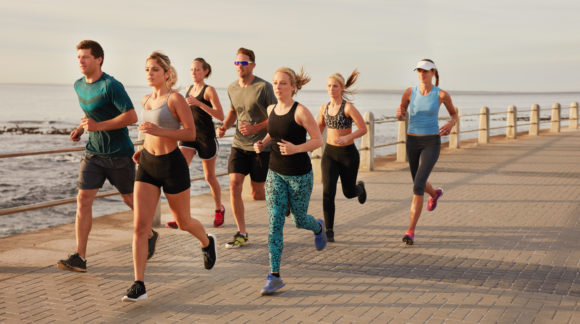Running

The Oldest Exercise for Mankind
Running is one of the basic forms of exercise available to all people. You don’t need expensive equipment or a monthly membership to become a runner, only a pair of socks and sneakers (unless you’re into barefoot running, which is a thing). It’s an exercise for all kinds and has been so for as long as we can trace human history.
Did you know in ancient times men ran hundreds of miles while hunting for food? This is still practiced today in Africa, Australia and North-Western Mexico. The Tarahumara tribes of native Mexican Indians still run long distances today.
It is suggested that running is now and has been a popular activity because it is a type of terrestrial locomotion. Terrestrial locomotion has three basic forms: legged, limbless locomotion and rolling. These movements can happen in water or on land and are the simplest movements that both humans and animals can make.
In the last 40 years recreational running has risen in popularity, which is attributed to the now-known health benefits of jogging, as well as the boom of competitive racing. Knowing the basics of your running gear, shoe fit, lacing, socks etc. are just as important to your physical health as knowing how to run.
The Benefits of Running
The benefits of running are better overall health and disease prevention, especially high blood pressure and heart attacks. In fact, the single greatest benefit of running is developing a strong heart.
As you morph into a regular jogger, you may experience the following benefits in addition to a healthier heart:
- Decreased stress level
- Increase confidence
- Weight loss
- Improved posture
- Increased energy levels
- Boost in positivity
- Deeper sleep
Running for Beginners
If you are new to the running world, professionals suggest starting with a plan, which may include warming up the muscles that will help you run two miles. For example, this eight-week running guide claims to have you running 30 minutes (about two miles) at a slow and relaxed pace in just more than 40 days. When you’re comfortable running for 30 minutes, you can expand your distance or time goals, as needed.
To start, you only need a pair of sneakers. Although, most beginners find it helpful to have the following equipment:
- Sneakers (try these beginner running shoes)
- Socks (try these socks for runners)
- Timer/GPS watch (try these popular watches)
- Water bottle (water bottles are great, so are these other hydration systems)
- MP3 player and ear buds (these are ideal for runners)
- Sunscreen/sunglasses/hat (if you are running outside)
- Reflective clothing or accessories (if you are running in the dark)
- Protein bar or snack (these are some of the best snacks for athletes)
Avoid These Common Mistakes
Whether you’ve been running for years or are new to the sport, these tips provide some guidance on mistakes you should avoid so you can master your form and increase your speed:
- Never cross-training – you should be working out other areas of your body in addition to running.
- New foods – before a run, stick to foods you know won’t upset your stomach.
- No rest – you need to plan for rest days if running is part of your normal schedule.
- Bad shoes – you need to replace running shoes every year or so.
- Not eating/drinking properly – your body can’t perform without the right fuel, so be sure to eat plenty of protein.
- Refusing to slow or stop – there is a difference between slowing down/resting and giving up. Learn to always listen to your body to prevent injuries, because it never talks to you unless something’s wrong.
- Ignoring your surroundings – if you run outside, always pay attention to who might be behind you, especially if you are listening to music and can’t hear outside noise.
- Going too fast – speed isn’t everything, so be aware when you are pushing yourself too far.
- Ignoring injuries – if something hurts, give it a rest and see if it improves. If you’re “powering through” pain, be sure it’s not a serious injury.
- Running alone – running alone is sometimes better, but running in a group can help you run faster and help you learn new techniques. Mix it up.
In as little as eight weeks, you’ll be able to add “runner” to the list of words to describe yourself.
Additional Resources
- Getting Started, by runningforfitness.org
- Beginners Guide to Running, by Zuzana
- When Did the History of Running Begin, by myrunningtips.com
- 4 Steps to Make Running a Hobby of Habitual Happiness, by The RUNSOCIETY TEAM
- 10 Steps to Start Running, by Jeff Galloway
- 6 Benefits of Running, by Jacqule Cattanach
- The Greatest Runners, by runnersworld.com
- Running Tips: How to Get Started, by Women’s Health
Videos
- How to Make Running Your Favorite Hobby, by mustbefit.net
- How to Have Proper Running Form, by Howcast
- How to Run: Do’s and Don’ts, by THNKR
- The Marathon – Running Through History, by Jon D
Education
- Healthy Running Medical Education, by newtonrunning.com
- Road Runners Club of America, by rrca.org/education
- Healthy Running Continuing Education, by topoathletic.com
- The Running Course – The Next Step, by healthclick.com
Books
- Running fitness book, by Paul Astor
- Run Fast. Eat Slow, by Shalane Flanagan and Elyse Kopecky
- First Ladies of Running, by Amby Burfoot
- Strength Training for Runners, by Mirsad Hasic
- The Science of Running, by Steve Magness
Apps
- Nike + Run Club, by Nike, Inc
- 8 Weeks to 5k-Training Program, by Personal Running Trainer, available on iTunes for a fee
- Best Running Music Playlist, by Ibiza fitness Music Workout, available on iTunes for a fee
